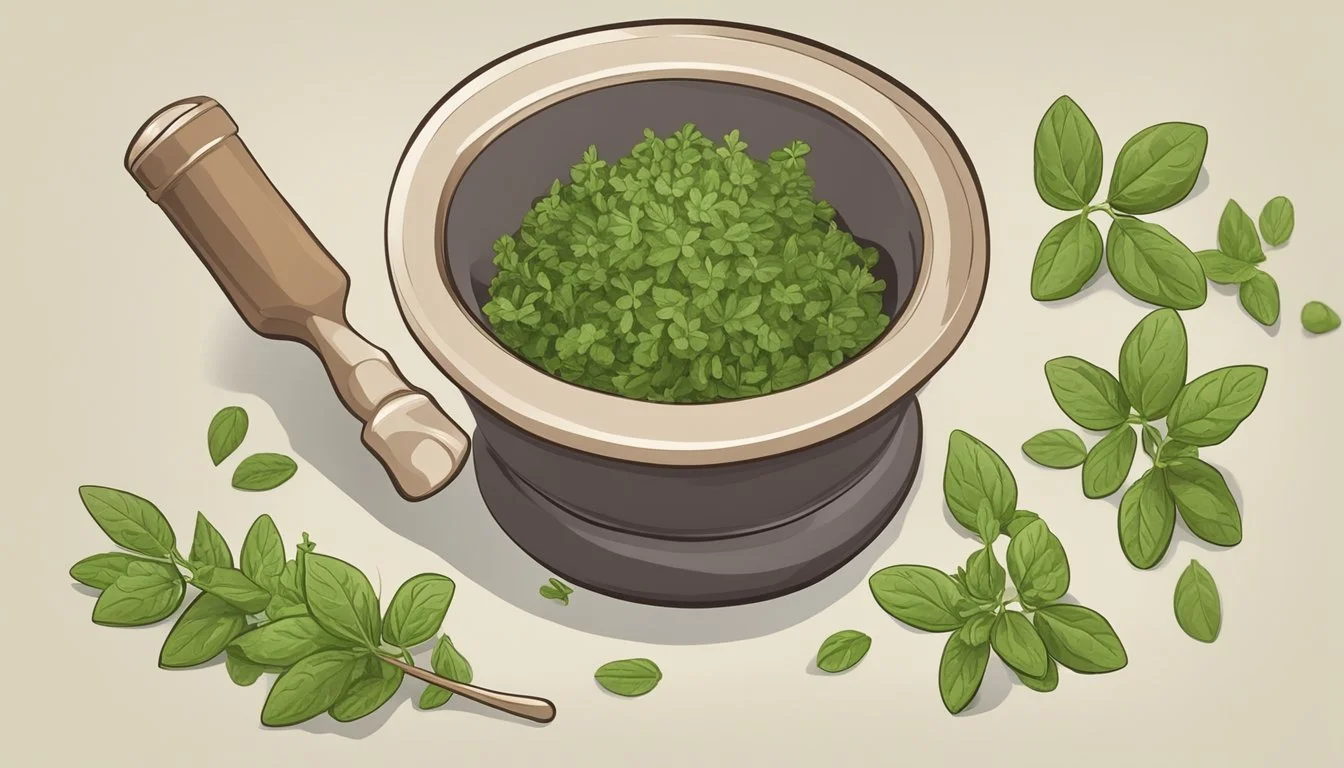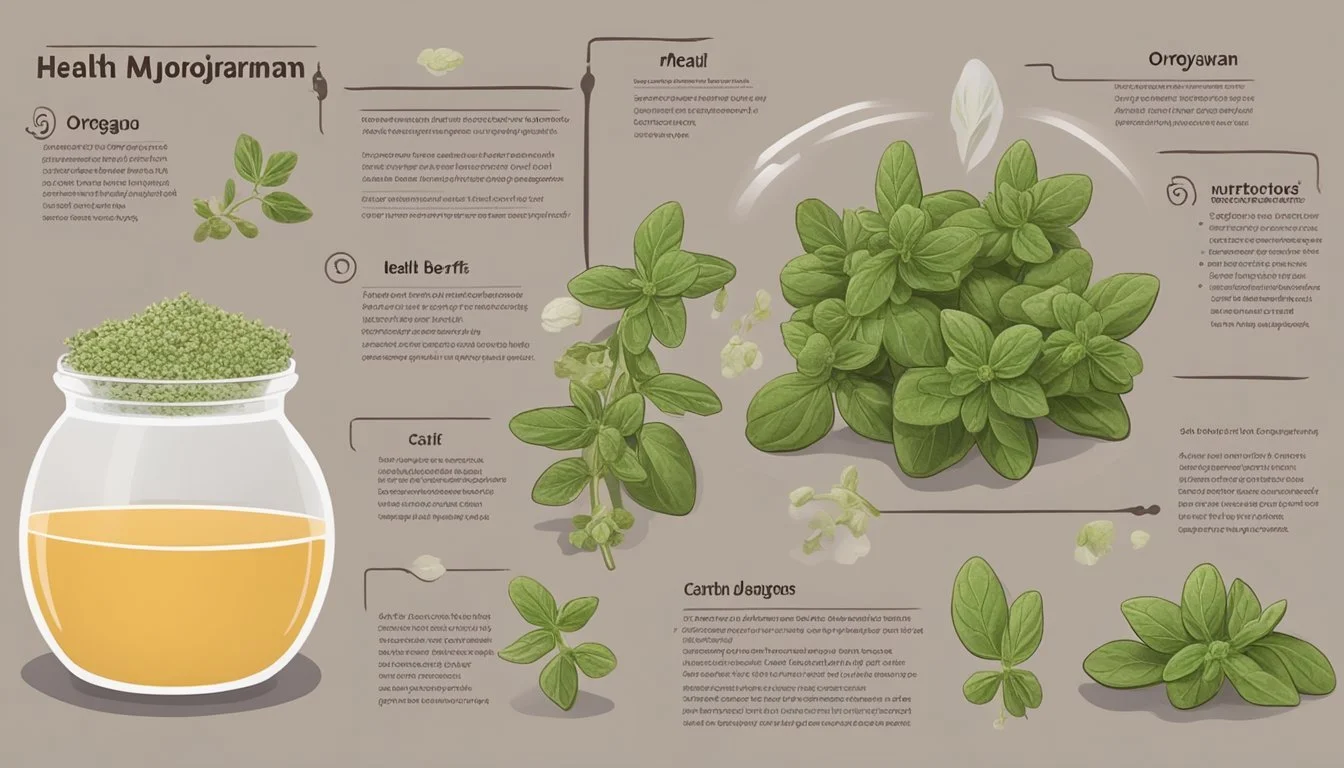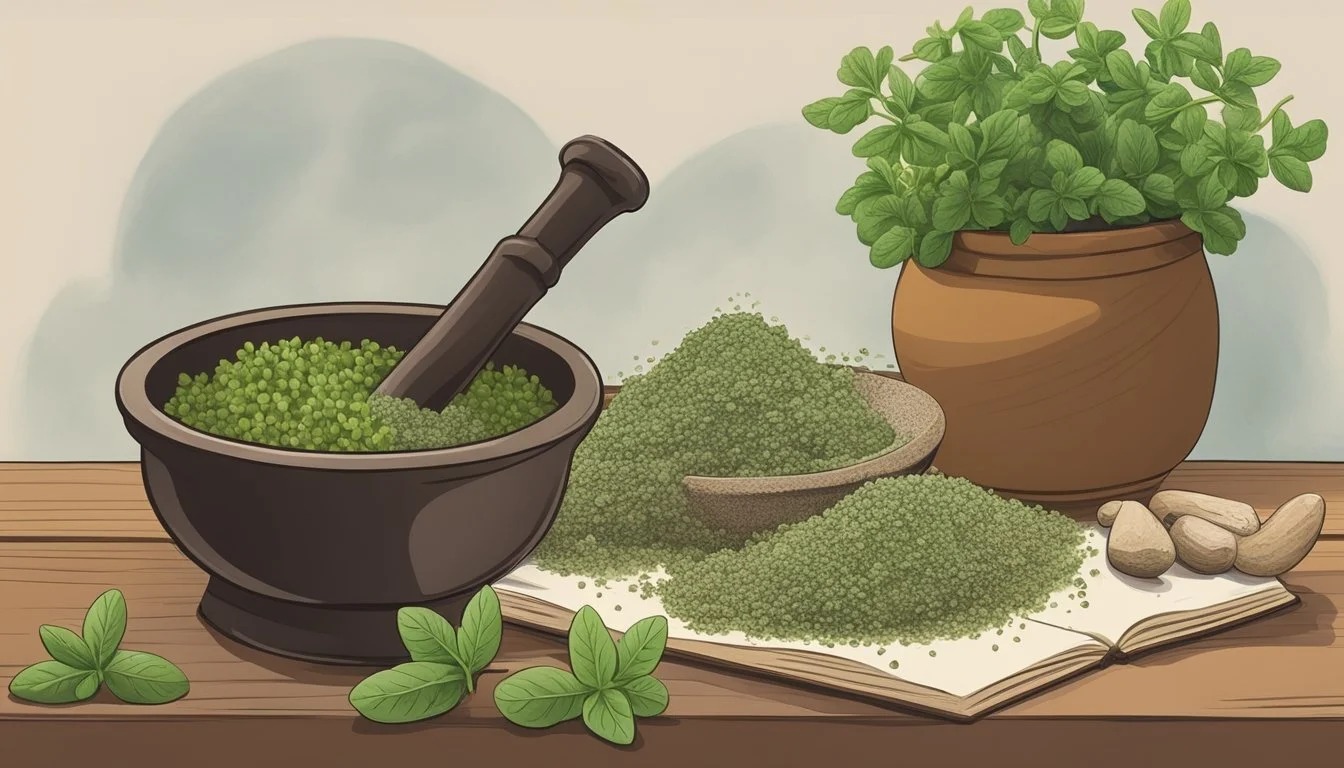How to Substitute Marjoram for Oregano
Simple Swap Tips
Marjoram and oregano are two herbs that are often confused due to their similar appearance and closely related botanical family. While they share some characteristics, each herb brings its own unique flavor profile to a dish. Marjoram, sweet with a hint of citrus, tends to be milder than its counterpart. Oregano, on the other hand, offers a more robust, spicy taste which holds up well in heartier dishes and is commonly associated with Italian cuisine.
When it comes to cooking, the versatility of these herbs means they can often be used interchangeably; however, the substitution is not a simple one-to-one ratio due to their potency differences. In recipes calling for marjoram, when one does not have it on hand, oregano can step in as a substitute, keeping in mind the stronger flavor. It is recommended to start with half the amount of oregano in place of marjoram, adjusting to taste.
Understanding the subtle differences between these two helps cooks and chefs adapt their recipes without compromising the integrity of their dishes. In culinary applications where marjoram's gentle sweetness is desired, oregano's boldness can be tempered, albeit with careful measurement. It is important to note that the best substitutions often depend on the particular recipe and desired outcome, making it clear that knowing when and how to substitute one herb for the other is an invaluable skill in any kitchen.
Understanding Herbs and Substitutes
Marjoram and oregano are both prominent herbs in Mediterranean cuisine, and understanding their characteristics is essential for substitution. Each herb offers distinct flavors and can be used in both fresh and dried forms.
The Basics of Marjoram
Marjoram is a perennial herb known for its sweet and savory flavor profile, which is milder than oregano. It's found fresh or dried and is commonly used in Mediterranean dishes. When substituting marjoram for oregano, it's critical to consider the strength of flavor. For every tablespoon of fresh marjoram required, one can use 1 teaspoon of dried marjoram.
Common Uses of Oregano
Oregano has a robust, earthy flavor that makes it a versatile seasoning for various dishes. It’s often found in sauces, salad dressings, meats, and vegetable dishes. When oregano is fresh, its flavor is less concentrated than when it's dried. To substitute for marjoram, particularly in Mediterranean dishes, oregano can be used in a 1:1 ratio, but one might adjust quantities since oregano has a stronger flavor.
Substitution Ratios
When substituting marjoram for oregano, understanding the correct ratios and adjustments for the disparity in flavor strength and form—fresh or dried—is crucial.
Fresh vs. Dried Herbs
For fresh marjoram as a substitute for fresh oregano, the ratio is a straightforward 1:1. When using dried marjoram in place of dried oregano, this same 1:1 ratio applies. However, one should be aware of the general rule that dried herbs have a more concentrated flavor than fresh. Therefore, when converting from fresh to dried, use 1 teaspoon of dried marjoram for every tablespoon of fresh marjoram needed.
Adjusting Flavors
Considering that marjoram is typically milder than oregano, one might opt to slightly increase the amount of marjoram to achieve a comparable potency. Taste and adjust incrementally, particularly if using dried marjoram, since its potency is greater than that of fresh. For those who find oregano's flavor overly assertive, marjoram serves as an ideal milder substitute without significantly altering the dish's intended flavor profile.
Marjoram and Oregano in Cooking
Marjoram and oregano are versatile herbs that are commonly used in a variety of dishes, from Italian pasta to meat dishes, offering distinctive yet complementary flavors.
Incorporating in Recipes
Incorporating marjoram in place of oregano in recipes is straightforward. Chefs can substitute them in a 1:1 ratio for most dishes. This is especially true for recipes like Italian sauces, dressings, and soups where oregano typically features. Marjoram's more delicate flavor pairs well with poultry and vegetables, complementing these foods without overpowering them.
In pasta dishes: Use marjoram to gently accent the flavors rather than dominate the dish.
Within soups: Marjoram can add a subtle depth without the strong zest that oregano imparts.
For vegetable dishes: Marjoram is a natural companion, enhancing their natural flavors.
Impact on Taste
The taste of marjoram is sweeter and milder with a note of pine, making it less overpowering than oregano.
Oregano's flavor is robust, spicy, and slightly bitter, which stands up well in heartier and richer meat dishes.
Marjoram's aroma is more refined and floral, which can introduce a nuanced fragrance to sauces and dressings, where oregano might otherwise dominate.
When marjoram replaces oregano in Italian recipes, it should be added toward the end of cooking to preserve its delicate flavor.
Using these guidelines, cooks can maintain the balance and harmony in their dishes by thoughtfully incorporating marjoram or oregano to suit the profile of the recipe.
Alternative Herbs to Consider
When substituting marjoram with other herbs, one must match the flavor profile as closely as possible. Sage, thyme, and herbes de Provence are all suitable options, each bringing a distinct quality to dishes.
Sage as Substitute
Sage, with its earthy and slightly peppery taste, is an ideal substitute for marjoram in many recipes. It works well in:
Meat dishes: Use 1 teaspoon of dried sage to replace 2 teaspoons of dried marjoram.
Poultry recipes: Incorporate sage similar to marjoram for a complementary flavor.
Thyme and Its Uses
Thyme offers a subtle, dry aroma and a minty flavor that can mirror marjoram's effects in cooking. Its uses include:
Vegetable dishes: Thyme can be sprinkled over roasted or steamed vegetables.
Soups and stews: Add thyme to impart a savory depth.
Exploring Herbes de Provence
Herbes de Provence is a blend that commonly includes thyme, basil, and sometimes tarragon. This mixture is ideal as a marjoram substitute in:
French cuisine: It excels in traditional dishes like ratatouille or roast chicken.
Grilled foods: Sprinkle herbes de Provence on meats before grilling to enhance flavor.
Culinary Tips for Using Marjoram
Marjoram, often used in Mediterranean dishes, provides a sweet and citrusy aroma that can enhance a range of culinary creations. Whether fresh or dried, sweet marjoram or knotted marjoram, understanding how to handle these herbs is essential for successful cooking.
Fresh Marjoram Handling
Fresh marjoram should be washed gently under cold water to remove any dirt and then patted dry with a paper towel. The leaves are best stripped from the stems just before use to retain their fragrant oils. Storage of fresh marjoram involves wrapping the herb in damp paper towels and placing it inside a resealable plastic bag in the refrigerator, where it can last for a few days.
Usage: Incorporate full sprigs into roasting or slow-cooking dishes to allow the flavor to infuse.
Proportion: When substituting for oregano, use a generous 1:1 ratio, as marjoram is milder in flavor.
Using Dried Marjoram in Dishes
Dried marjoram offers a more concentrated flavor and is thus used in smaller quantities. It should be stored in a cool, dry place, away from sunlight, in an airtight container to maintain its potency.
Cooking Process: Add dried marjoram early in the cooking process to dishes such as soups, stews, or sauces to allow its flavor to develop.
Substitution: Due to its potent nature, when using dried marjoram in place of fresh, the ratio is 1 teaspoon of dried for every tablespoon of fresh required.
By incorporating these specific handling and substitution methods, marjoram can be effectively used to imbue dishes with its unique flavor profile.
Health Benefits and Nutritional Value
Marjoram and oregano, while often used interchangeably as culinary herbs, possess distinct nutritional benefits and health properties. They contribute to a diet rich in antioxidants and may offer support in areas such as digestion and inflammation management.
Marjoram in Herbal Teas
Marjoram is commonly used in herbal tea blends for its potential digestive benefits. It contains essential oils that may soothe the digestive system and alleviate minor digestive discomforts. As a nutritional addition to herbal teas, marjoram offers vitamins such as Vitamin A and Vitamin C, as well as minerals like iron and manganese.
Nutritional constituents in Marjoram Teas (per teaspoon):
Calories: Minimal
Carbohydrates: Negligible
Protein: Trace amounts
Dietary Fiber: Slight content
Vitamins:
Vitamin A: Present
Vitamin C: Moderate
Minerals:
Calcium: Present
Iron: Higher concentration
Potassium: Present
Antioxidant Properties of Oregano
Oregano is recognized for its antioxidant properties, which can be attributed to its high content of polyphenols and flavonoids. These compounds may contribute to the reduction of oxidative stress within the body and could play a role in moderating inflammatory responses. While oregano contains less Vitamin C than marjoram, it provides a notable amount of Vitamin E and dietary fiber, beneficial for overall health.
Antioxidant compounds in Oregano:
Polyphenols: Abundant
Flavonoids: Abundant
Vitamins contributing to antioxidant activity:
Vitamin E: Significant presence
Vitamin C: Less than Marjoram
Essential Oil: Known to contain antioxidative elements
By understanding the nutritional profiles and health benefits of marjoram and oregano, individuals can make informed decisions when substituting one for the other in culinary applications, maximizing both flavor and health potential.
Cultural Significance and History
Marjoram and oregano have rich histories rooted in their use across various cuisines. Each herb carries cultural significance that reflects its culinary and symbolic roles across civilizations.
Marjoram in Mediterranean Cuisine
In Mediterranean cuisine, marjoram is a cherished herb, regarded for its aromatic properties and its role in regional cooking. Known as "sweet marjoram," its gentle flavor is a staple in classic seasoning blends such as Herbs de Provence and za'atar. Marjoram's historical use extends beyond the kitchen; it symbolized happiness in both Greek and Roman cultures. Chefs often use marjoram to season soups, sauces, and meat dishes, adhering to traditional recipes passed down through generations.
Uses in Mediterranean Dishes:
Soups and stews
Meat marinades and rubs
Traditional seasoning blends (e.g., Herbs de Provence, za'atar)
Cultural Associations:
A symbol of happiness in ancient Greece and Rome
Present in traditional Mediterranean festivals and ceremonies
Oregano in American and Middle Eastern Cuisine
Oregano features prominently in American cuisine, especially within Italian-American dishes. Its robust flavor anchors the taste of pizza, pasta sauces, and grilled meats. In Middle Eastern cuisine, the herb is utilized both fresh and dried, particularly in spice mixes and meat preparations. Oregano's potent taste and versatility have made it an indispensable ingredient in American kitchens and a key component in Middle Eastern dishes like kebabs. Additionally, oregano, sometimes referred to as "wild marjoram" in Europe, can often find its way into pot marjoram varieties used in gardening.
Key Uses:
Italian-American dishes (e.g., pizza, pasta sauces)
Middle Eastern spice mixes and meat dishes
Varietal Information:
Pot marjoram is a common variant used in American and European gardens
Integration into Middle Eastern spice blends such as za'atar
Selecting and Storing Herbs
Proper selection and storage of herbs are crucial for maintaining their flavor and potency. Whether one is dealing with fresh or dried herbs, understanding their shelf life and the best storage practices ensures that their aromatic qualities are preserved until use.
Shelf Life of Herbs
Fresh Herbs: Fresh herbs generally have a short shelf life. When stored in the refrigerator, most fresh herbs should be used within:
1 week for tender herbs like basil and cilantro
2 weeks for hardier herbs like marjoram and oregano
Dried Herbs: Dried herbs, on the other hand, can last considerably longer. Shelf life for dried herbs, when stored properly, can be up to:
1 to 3 years for whole dried herbs
6 months to 1 year for ground herbs
Best Practices for Storage
Fresh Herbs Storage:
Wrap fresh herbs loosely in a damp paper towel.
Place them in a zip-lock bag, but do not seal entirely to allow for air circulation.
Store in the refrigerator's crisper drawer, away from fruits.
Store in a cool, dark, and dry place inside airtight containers.
Avoid proximity to heat sources such as the stove or sunlight which can degrade flavor.
Label containers with the date to keep track of freshness.
Creative Uses Beyond Cooking
While typically celebrated for their culinary applications, both marjoram and oregano have uses that extend far beyond the kitchen. These herbs can be utilized for their aromatic and therapeutic properties, lending their distinctive fragrance and benefits to various non-cooking contexts.
Marjoram in Aromatherapy
Marjoram's sweet and woodsy scent makes it a favored choice in aromatherapy. As an essential oil, marjoram is regarded for its calming and soothing properties, which can help alleviate stress and promote relaxation. In addition to its aromatic qualities, the essential oil derived from marjoram is believed to support the nervous and cardiovascular systems, enhancing overall well-being when used responsibly and with appropriate guidance.
Oregano in Household Applications
Beyond its bold and earthy flavor in cooking, oregano has a place in household applications. Its essential oil is commonly used as a natural cleaning agent due to its antimicrobial properties. Oregano oil can be added to homemade cleaning solutions to help disinfect surfaces while leaving a refreshing herbal scent throughout the home. Here's a simple recipe for an oregano-infused cleaner:
Homemade Oregano Cleaner Recipe
Ingredients:
Water
White vinegar
Oregano essential oil
Instructions:
Fill a spray bottle with equal parts water and white vinegar.
Add 10-15 drops of oregano essential oil.
Shake well to combine.
Use as needed on surfaces, wiping with a cloth after spraying.
This recipe provides an effective and natural alternative to commercial cleaning products, and the presence of oregano oil imparts not only a clean environment but also a subtly spicy and herbaceous aroma.






